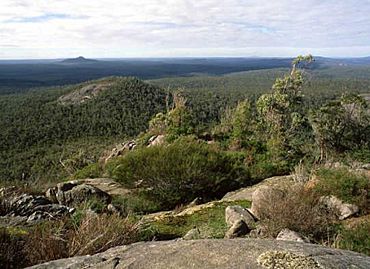Walpole Wilderness Area facts for kids
Quick facts for kids Walpole Wilderness AreaWestern Australia |
|
|---|---|
|
IUCN Category II (National Park)
|
|

Walpole Wilderness Area
|
|
| Nearest town or city | Walpole |
| Established | 1957 |
| Area | 3,633.33 km2 (1,402.8 sq mi) |
| Managing authorities | Department of Environment and Conservation |
| See also | List of protected areas of Western Australia |
The Walpole Wilderness Area is a special collection of protected lands. It's located on the south coast of Western Australia. This huge area is home to many different things. You'll find big forests with trees like jarrah, red tingle, and karri. There are also granite hills, rivers, open heathlands, and wetlands. Along the coast, you can see inlets, sandy beaches, tall cliffs, and the Southern Ocean.
This wilderness area connects with Shannon and D'Entrecasteaux National Parks. Together, they form a continuous protected zone. This zone stretches from near Augusta in the west to Denmark in the east.
Contents
What Makes Up the Walpole Wilderness Area?
The Walpole Wilderness Area includes many different parks and reserves. These protected places work together to keep the natural environment safe.
Here are some of the areas it includes:
- Walpole-Nornalup National Park
- Shannon National Park
- Mount Frankland National Park
- William Bay National Park
- Mount Frankland North National Park
- Mount Frankland South National Park
- Mount Roe National Park
- Mount Lindesay National Park
- Quarram Nature Reserve
- Owingup Nature Reserve
- Mehniup Nature Reserve
- Mount Shadforth Nature Reserve
- Boynaminup National Park
- Kordabup Nature Reserve
History of the Walpole Wilderness Area
The idea for the Walpole Wilderness Area started in 1998. Two people, Donna Selby and Cath Roberts, from the South Coast Environment Group, first suggested it. At that time, there was a big discussion about cutting down very old trees (called old-growth logging).
The proposal aimed to protect the region's nature. It suggested linking existing parks and reserves. This would create one large, connected conservation area. The plan also wanted to include the towns and farms nearby. It hoped to create a special connection between local people, visitors, and nature.
The idea was to help develop nature-based activities. This would also create new businesses. The plan aimed to improve tourism while keeping the environment healthy for a long time. The Western Australian Labor government officially adopted the Walpole Wilderness Area on April 22, 2001. This happened under Premier Geoff Gallop.
Why the Walpole Wilderness Area is Important
This area has always been known for its amazing natural beauty. It has unique plants and animals, many of which are found nowhere else. It also has stunning scenery.
The Walpole Wilderness Area is important for several reasons:
- Wilderness Qualities: It offers vast, untouched natural spaces.
- Old-Growth Forests: It protects ancient forests with very old trees.
- Diverse Landscapes: It has a mix of heathlands, wetlands, and granite rock formations.
- Biodiversity Hotspot: It is part of a "biodiversity hotspot." This means it has a very high number of different plant and animal species. Many of these species are at risk.
- Many Rivers: Several rivers start or flow through the area. These include the Deep, Weld, Walpole, Frankland, Bow, Kent, Styx, Denmark, Mitchell, and Hay rivers.
- Fun Activities: There are many things to do, from hiking in the wilderness to visiting places like the Tree Top Walk.
- Cultural Heritage: It has a rich history for both Indigenous people and later settlers.
See also
 In Spanish: Área silvestre de Walpole para niños
In Spanish: Área silvestre de Walpole para niños


